Mine Water Production, Treatment, and Utilization in the Yellow River Basin: Spatial Patterns and Sustainable Transformation Pathways
Abstract
1. Introduction
2. Materials and Methods
2.1. Site Description
2.2. Data Sources and Pre-Processing
2.2.1. Coal Production and Mine Water Production
2.2.2. Large Coal Base and National Planned Coal Mining Area Location
2.2.3. Bibliometric Metadata (CNKI)
2.3. Analytical Methods
2.3.1. Kernel Density Estimation
2.3.2. Center of Gravity Transfer Model
2.3.3. Scientometric Analysis by CiteSpace
2.4. Design of Case Study and Field Investigation
3. Results and Discussion
3.1. Regional Spatial Context of Mine Water Production in the Yellow River Basin
3.2. Spatial–Temporal Characteristics and Evolution of Mine Water Production
3.3. Evolution and Frontier Hotspots of Mine Water Treatment and Utilization Research
3.3.1. Analysis of Annual Publication Trends
3.3.2. Key Research Directions
3.4. Case Study Analysis and Identification of Treatment and Utilization Shortcomings
4. Outlook and Future Trends
4.1. Optimization of Technical Paths for Mine Water Treatment and Utilization
4.2. Expansion of the Utilization Path of Mine Water Resources
4.3. Construction of Regional Coordination Mechanism
5. Conclusions
Author Contributions
Funding
Data Availability Statement
Conflicts of Interest
References
- Xin, Y.; Liu, X.Y. Coupling driving factors of eco-environmental protection and high-quality development in the yellow river basin. Front. Environ. Sci. 2022, 10, 951218. [Google Scholar] [CrossRef]
- Xi, F.R.; Yan, R.W.; Shi, J.S.; Zhang, J.D.; Wang, R.P. Pumped storage power station using abandoned mine in the Yellow River basin: A feasibility analysis under the perspective of carbon neutrality. Front. Environ. Sci. 2022, 10, 983319. [Google Scholar] [CrossRef]
- Zhang, L.Y.; Song, M.; Zhang, J.; Hao, X.G. Multiscale spatiotemporal evolution and zoning of energy consumption carbon footprint in the Yellow River Basin. Energy Sci. Eng. 2024, 12, 4662–4679. [Google Scholar] [CrossRef]
- Sun, K.; Han, J.M.; Wu, Q.R.; Xie, W.S.; He, W.B.; Yang, Z.Z.; Wang, Y.B.; Liu, J.C.; Shi, E.H. The coupling coordination and spatiotemporal evolution of industrial water-energy-CO2 in the Yellow River Basin. Sci. Total Environ. 2024, 912, 169012. [Google Scholar] [CrossRef] [PubMed]
- Wang, H.; Ma, T. Optimal water resource allocation considering virtual water trade in the Yellow River Basin. Sci. Rep. 2024, 14, 79. [Google Scholar] [CrossRef]
- Gu, Y.X.; Zhou, Z.N.; Li, Y.M. Research on resource utilization of mine water in goaf. Coal Sci. Technol. 2007, 35, 90–92. (In Chinese) [Google Scholar] [CrossRef]
- Xia, Y.S.; Shi, J.J.; Zhao, Z.N.; Liu, Z.; Liu, X.H.; Zhang, C. Mapping the coal-water nexus in the Yellow River Basin. J. Clean. Prod. 2023, 411, 137249. [Google Scholar] [CrossRef]
- Wu, Q.; Gao, J.L.; Zeng, Y.F.; Cheng, Y.; Wang, Y.X. Strategic Research on Mine Water Resource Protection and Utilization in Coal Mines of the Yellow River Basin. J. China Coal Soc. 2025, in press (In Chinese with abstract in English). [Google Scholar] [CrossRef]
- Liu, B.W.; Wang, Z.W.; Zhao, G.F.; Guo, M.G.Z.; Su, P.D. Environmental impact analysis and low-carbon transition strategies for the coal chemical industry in the yellow river basin. J. Clean. Prod. 2025, 526, 146644. [Google Scholar] [CrossRef]
- Zhang, S.Y.; Wang, H.; He, X.W.; Guo, S.Q.; Xia, Y.; Zhou, Y.X.; Liu, K.; Yang, S.P. Research progress, problems and prospects of mine water treatment technology and resource utilization in China. Crit. Rev. Environ. Sci. Technol. 2020, 50, 331–383. [Google Scholar] [CrossRef]
- Yang, Y.J.; Gong, R.J.; Wu, Q.Y.; Chen, F. Spatial-Temporal Changes in Ecosystem Service Value and Its Overlap with Coal Mining Intensity in the Yellow River Basin, China, During 2000–2030. ISPRS Int. J. Geo-Inf. 2024, 13, 412. [Google Scholar] [CrossRef]
- Guo, J.L.; Gao, J.L.; Yan, K.J.; Zhang, B. Unintended mitigation benefits of China’s coal de-capacity policies on methane emissions. Energy Policy 2023, 181, 113718. [Google Scholar] [CrossRef]
- Huo, C.; Liu, T.; Fan, B.; Zhao, Y.; Wang, D.; Zhang, J.; Zheng, C. Study on national coal resources exploration and exploitation layout under carbon neutrality and emission peak settings. Geol. Rev. 2022, 68, 938–944, (In Chinese with abstract in English). [Google Scholar] [CrossRef]
- Dai, W.T.; Yang, Y.G.; Li, Y.P.; Xie, F.; Wang, L.B.; Dong, J.H.; Zhong, M.; Wu, X.; Zeng, A.P.; Zhang, H. Stress analysis of coal mining sites on Shandong Province’s critical ecological space in the Yellow River Basin, China. All Earth 2025, 37, 1–11. [Google Scholar] [CrossRef]
- Fu, Y.C.; Zhang, J.; Li, H.X.; Fu, M.; Chen, H. From mine drainage to river lifeline: An ecological indicator-driven framework for circular water management and SDG synergies in mining basins. Ecol. Indic. 2025, 177, 113749. [Google Scholar] [CrossRef]
- Chen, M.H.; Zhao, J.F.; Zhao, S. Measurement and evaluation of agricultural technological innovation efficiency in the Yellow River Basin of China under water resource constraints. Heliyon 2024, 10, e32521. [Google Scholar] [CrossRef]
- Li, X.; Du, S.; Hu, S.H.; Dong, D.L.; Jiang, D.; Cao, C.L.; Lin, G.; Fu, J.Y. Simulation of surface water-groundwater interaction in coal mining subsidence areas: A case study of the Kuye River Basin in China. J. Hydrol. 2025, 659, 133243. [Google Scholar] [CrossRef]
- Zhang, M.; Wang, J.P.; Zhou, R.J. Sustainable effect of coal mining on hydrological drought risk: A case study on Kuye river basin, China. Nat. Hazards 2020, 103, 2929–2943. [Google Scholar] [CrossRef]
- Sun, W.J.; Yu, Q.; Xu, C.L.; Zhao, J.K.; Wang, Y.; Miao, Y.L. Construction and optimization of ecological spatial network in typical mining cities of the Yellow River Basin: The case study of Shenmu City, Shaanxi. Ecol. Process. 2024, 13, 60. [Google Scholar] [CrossRef]
- Liu, S.T.; Yu, F.R.; Lang, T.; Ji, Y.K.; Fu, Y.; Zhang, J.N.; Ge, C. Spatial distribution of heavy metal contaminants: The effects of water-sediment regulation in the Henan section of the Yellow River. Sci. Total Environ. 2023, 892, 164568. [Google Scholar] [CrossRef]
- Zeng, P.; Liang, L.Y.; Duan, Z.C. Ecological and environmental impacts of mineral exploitation in urban agglomerations. Ecol. Indic. 2023, 148, 110035. [Google Scholar] [CrossRef]
- Song, S.J.; Zheng, B.B.; Sun, T.; Du, L.; Wei, J.B. Influence of Different Mining Damage Types on Soil Erodibility in Coal Mining Areas of Northern Shaanxi in the Middle Reaches of the Yellow River in China. Sustainability 2023, 15, 5434. [Google Scholar] [CrossRef]
- Yue, J.C.; Wang, X.Y.; Wei, Y.H.; Luo, W.J.; Zheng, L.J.; Guo, S.T. Optimal configuration for multi-purpose mine water quality-classified utilization. Energy Sources Part A 2023, 45, 6620–6637. [Google Scholar] [CrossRef]
- Zeng, Y.F.; Liu, X.X.; Wu, Q.; Liang, J.Y. Theory and technical conception of coal–water–thermal positive synergistic co–extraction under the dual carbon background. J. China Coal Soc. 2023, 48, 538–550, (In Chinese with abstract in English). [Google Scholar] [CrossRef]
- Xu, Q.Q.; Shu, S.L. A study of the impact of digital technology on industrial ecologisation in the Yellow River Basin of China. Sci. Rep. 2023, 13, 22468. [Google Scholar] [CrossRef] [PubMed]
- National Development and Reform Commission. Flood Control Planning for the Yellow River Basin. Available online: https://www.ndrc.gov.cn/fggz/fzzlgh/gjjzxgh/201604/P020191104623960850846.doc (accessed on 9 November 2025). (In Chinese)
- Shang, Y.Z.; Hei, P.F.; Lu, S.B.; Shang, L.; Li, X.F.; Wei, Y.P.; Jia, D.D.; Jiang, D.; Ye, Y.T.; Gong, J.G.; et al. China’s energy-water nexus: Assessing water conservation synergies of the total coal consumption cap strategy until 2050. Appl. Energy 2018, 210, 643–660. [Google Scholar] [CrossRef]
- Okadera, T.; Watanabe, M.; Xu, K.Q. Analysis of water demand and water pollutant discharge using a regional input-output table: An application to the City of Chongqing, upstream of the Three Gorges Dam in China. Ecol. Econ. 2006, 58, 221–237. [Google Scholar] [CrossRef]
- Sun, W.J.; Zhou, W.F.; Jiao, J. Hydrogeological Classification and Water Inrush Accidents in China’s Coal Mines. Mine Water Environ. 2016, 35, 214–220. [Google Scholar] [CrossRef]
- Wang, X.; Zhang, C.; Yuan, J.; Sui, X.; Di, S.J.; Wang, H.Y. Life Cycle Assessment of Mine Water Resource Utilization in China: A Case Study of Xiegou Coal Mine in Shanxi Province. Sustainability 2025, 17, 229. [Google Scholar] [CrossRef]
- National Development and Reform Commission. 13th Five-Year Mine Safety Production Planning. Available online: https://en.ndrc.gov.cn/policies/202105/P020210527785800103339.pdf (accessed on 11 November 2025). (In Chinese)
- National Mine Safety Administration (2021) National Plan for Mineral Resources (2016–2020). Available online: https://www.ndrc.gov.cn/fggz/fzzlgh/gjjzxgh/201705/t20170511_1196755.html (accessed on 11 November 2025). (In Chinese)
- Govorov, M.; Beconyte, G.; Gienko, G. Trivariate Kernel Density Estimation of Spatiotemporal Crime Events with Case Study for Lithuania. Sustainability 2023, 15, 8524. [Google Scholar] [CrossRef]
- Gelb, J.; Apparicio, P. Temporal Network Kernel Density Estimation. Geogr. Anal. 2024, 56, 62–78. [Google Scholar] [CrossRef]
- Zhao, Z.W.; Zhao, Z.Q.; Zhang, P. A new method for identifying industrial clustering using the standard deviational ellipse. Sci. Rep. 2023, 13, 578. [Google Scholar] [CrossRef]
- Guo, K.; Yuan, Y.B. Research on Spatial and Temporal Evolution Trends and Driving Factors of Green Residences in China Based on Weighted Standard Deviational Ellipse and Panel Tobit Model. Appl. Sci. 2022, 12, 8788. [Google Scholar] [CrossRef]
- Zuo, Z.L.; Cheng, J.H.; Guo, H.X.; Li, Y.L. Knowledge mapping of research on strategic mineral resource security: A visual analysis using CiteSpace. Resour. Policy 2021, 74, 102372. [Google Scholar] [CrossRef]
- Si, M.Y.; Zhang, Y.T.; Jin, H.; Long, Y.L.; Nie, T.; Feng, W.; Li, Q.S.; Lin, Y.C.; Xu, X.Q.; Wang, C.H. Research progress on acid mine drainage treatment based on CiteSpace analysis. Arch. Environ. Prot. 2024, 50, 104–115. [Google Scholar] [CrossRef]
- Sun, W.J.; Li, W.J.; Wu, Q.; Zhao, S.Q.; Liu, W.; Wang, C.X. Unraveling the Spatio-Temporal Pattern of Mine Water Accidents in China. Mine Water Environ. 2025, 44, 226–238. [Google Scholar] [CrossRef]
- Lin, G.; Dong, D.L.; Li, X.; Fan, P.W. Accounting for Mine Water in Coal Mining Activities and its Spatial Characteristics in China. Mine Water Environ. 2020, 39, 150–156. [Google Scholar] [CrossRef]
- Wei, L.; Zhou, L.; Sun, D.; Yuan, B.; Hu, F. Evaluating the impact of urban expansion on the habitat quality and constructing ecological security patterns: A case study of Jiziwan in the Yellow River Basin, China. Ecol. Indic. 2022, 145, 109544. [Google Scholar] [CrossRef]
- Fan, X.X.; Song, Y.H.; Liu, J.J.; Sun, F.; Shen, N.; Wei, Y.J.; Zhang, H.R.; Yuan, P.; Dai, Y.R. Research status and trend analysis of river water ecological evaluation based on CiteSpace. Environ. Pollut. Control 2025, 47, 123–130. (In Chinese) [Google Scholar] [CrossRef]
- Wu, Q.; Gao, J.L.; Zeng, Y.F.; Cheng, Y. Life–Cycle Protection and Utilization of Coal Mine Water in China. Strateg. Study CAE 2025, 27, 184–204, (In Chinese with abstract in English). [Google Scholar] [CrossRef]
- Ma, Y.Z.; Wang, H.Y.; Wu, Y.F.; Qiao, X.C.; Li, X.; He, J.T.; Liu, Y. Status Analysis and Control Suggestions on Comprehensive Utilization of Mine Water in the Yellow River Basin. Res. Environ. Sci. 2024, 37, 122–130. (In Chinese) [Google Scholar] [CrossRef]
- Gao, P.H.; Wang, Y.T.; Zhang, Z.H.; Cao, Y.R.; Liu, Z.; Zhang, D.H. The general methods of mine water treatment in China. Desalin. Water Treat. 2020, 202, 183–205. [Google Scholar] [CrossRef]
- Thiruvenkatachari, R.; Francis, M.; Cunnington, M.; Su, S. Application of integrated forward and reverse osmosis for coal mine wastewater desalination. Sep. Purif. Technol. 2016, 163, 181–188. [Google Scholar] [CrossRef]
- Moreira, V.R.; Guimaraes, R.N.; Moser, P.B.; Santos, L.V.S.; de Paula, E.C.; Lebron, Y.A.R.; Silva, A.F.R.; Casella, G.S.; Amaral, M.C.S. Restrictions in water treatment by conventional processes (coagulation, flocculation, and sand-filtration) following scenarios of dam failure. J. Water Process Eng. 2023, 51, 103450. [Google Scholar] [CrossRef]
- Zheng, L.B.; Tong, J.; Wei, Y.S.; Wang, J.; Yue, Z.G.; Wang, G. The progress of magnetic separation technology in water treatment. Acta Sci. Circumst. 2016, 36, 3103–3117. (In Chinese) [Google Scholar] [CrossRef]
- Li, H.; Xu, D.; Li, G.; Wei, S.R.; Wu, B.Y. Feasibility Study on the Construction of Underground Reservoirs in Coal Goaf-A Case Study from Buertai Coal Mine, China. Sustainability 2024, 16, 9912. [Google Scholar] [CrossRef]
- Li, X.; Chen, G.; Wei, W.; Tan, X.F.; Xu, Z.M.; Zhang, L.; Zhang, F.; Liu, Q.; Sun, Y.J. Feasibility of Injecting Pretreated Mine Water into a Deep Ordovician Aquifer in the Lilou Coal Mine, China. Mine Water Environ. 2024, 43, 168–182. [Google Scholar] [CrossRef]
- Dong, D.L.; Zhao, M.D.; Lin, G.; Zhao, W.J.; Zhang, K.; Li, N. Optimization of Water Pumping and Injection for Underground Coal Gasification in the Meiguiying Mine, China. Mine Water Environ. 2016, 35, 398–404. [Google Scholar] [CrossRef]
- Sun, W.J.; Wu, Q.; Dong, D.L.; Jiao, J. Avoiding Coal-Water Conflicts During the Development of China’s Large Coal-Producing Regions. Mine Water Environ. 2012, 31, 74–78. [Google Scholar] [CrossRef]
- Sun, W.B.; Wang, Y.; Zhang, L.M.; Liu, Y.D.; Wang, X. Establishing coal-water-wind (solar) energy comprehensive green energy mining system by using mine water. J. Water Clim. Change 2018, 9, 331–337. [Google Scholar] [CrossRef]
- Ma, Y.Z.; Lu, Y.N.; Li, F.; Liu, Y.; He, J.T. Creation of comprehensive utilization alternatives for coal mine water based on multi-criteria decision analysis: A case study of the Mengcun coal mine. J. Water Process Eng. 2025, 69, 106714. [Google Scholar] [CrossRef]
- Liu, C.S.; Liang, L.L.; Wang, L.; Zheng, S. Allocation and Utilization of Coal Mine Water for Ecological Protection of Lakes in Semi-Arid Area of China. Sustainability 2022, 14, 9042. [Google Scholar] [CrossRef]
- Gasperikova, E.; Ulrich, C.; Omitaomu, O.A.; Dobson, P.; Zhang, Y. Multicriteria screening evaluation of geothermal resources on mine lands for direct use heating. Geotherm. Energy 2024, 12, 11. [Google Scholar] [CrossRef]
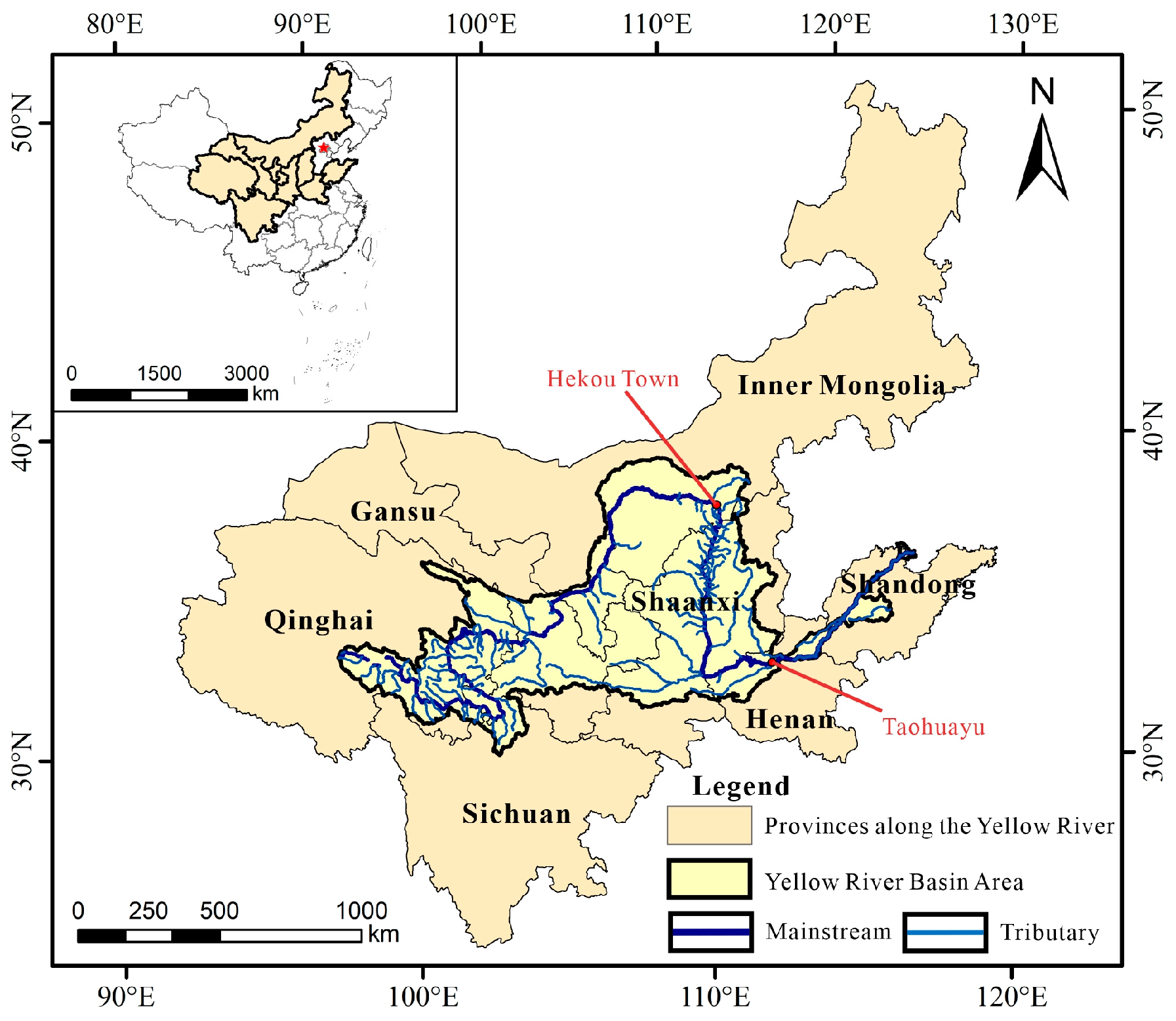

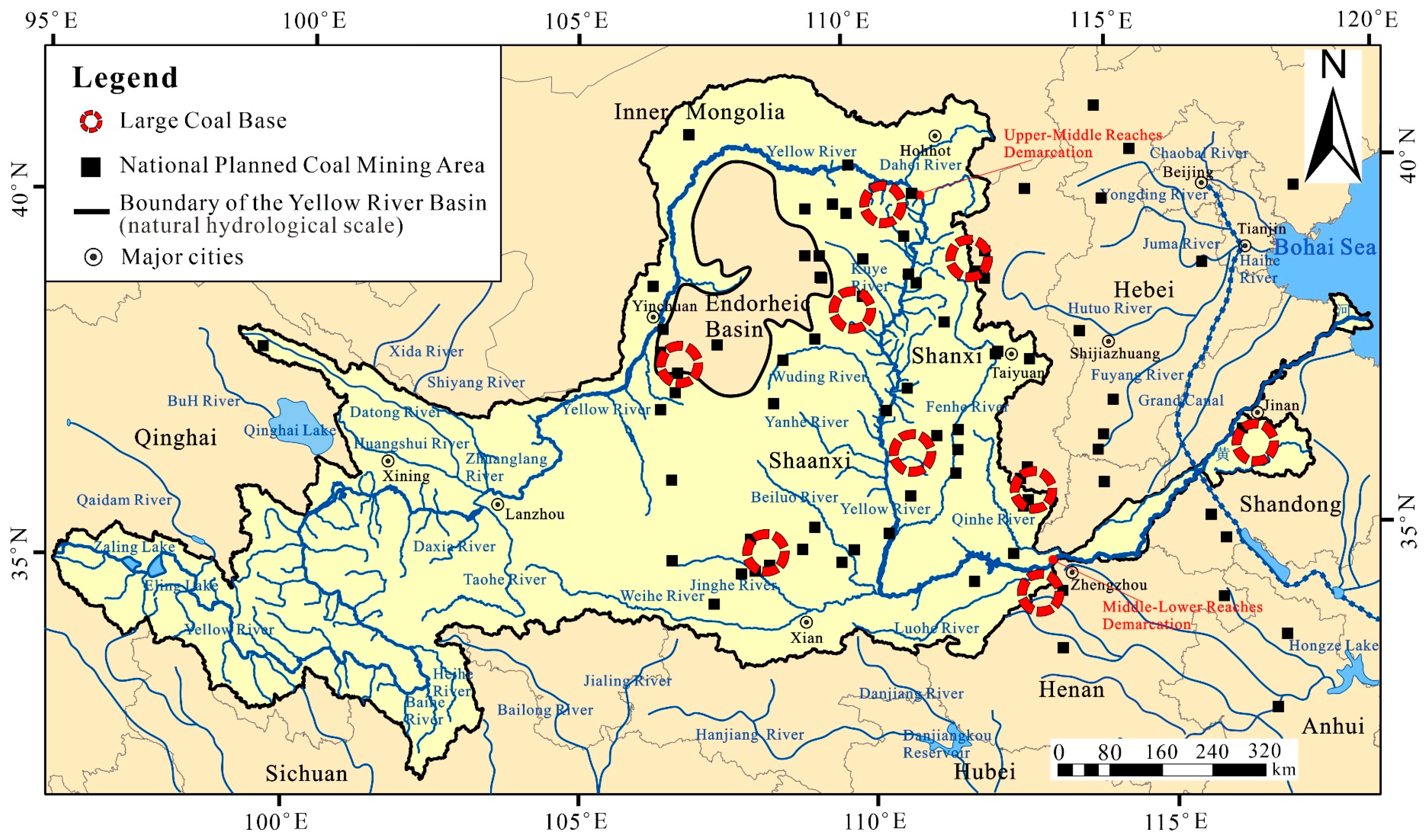

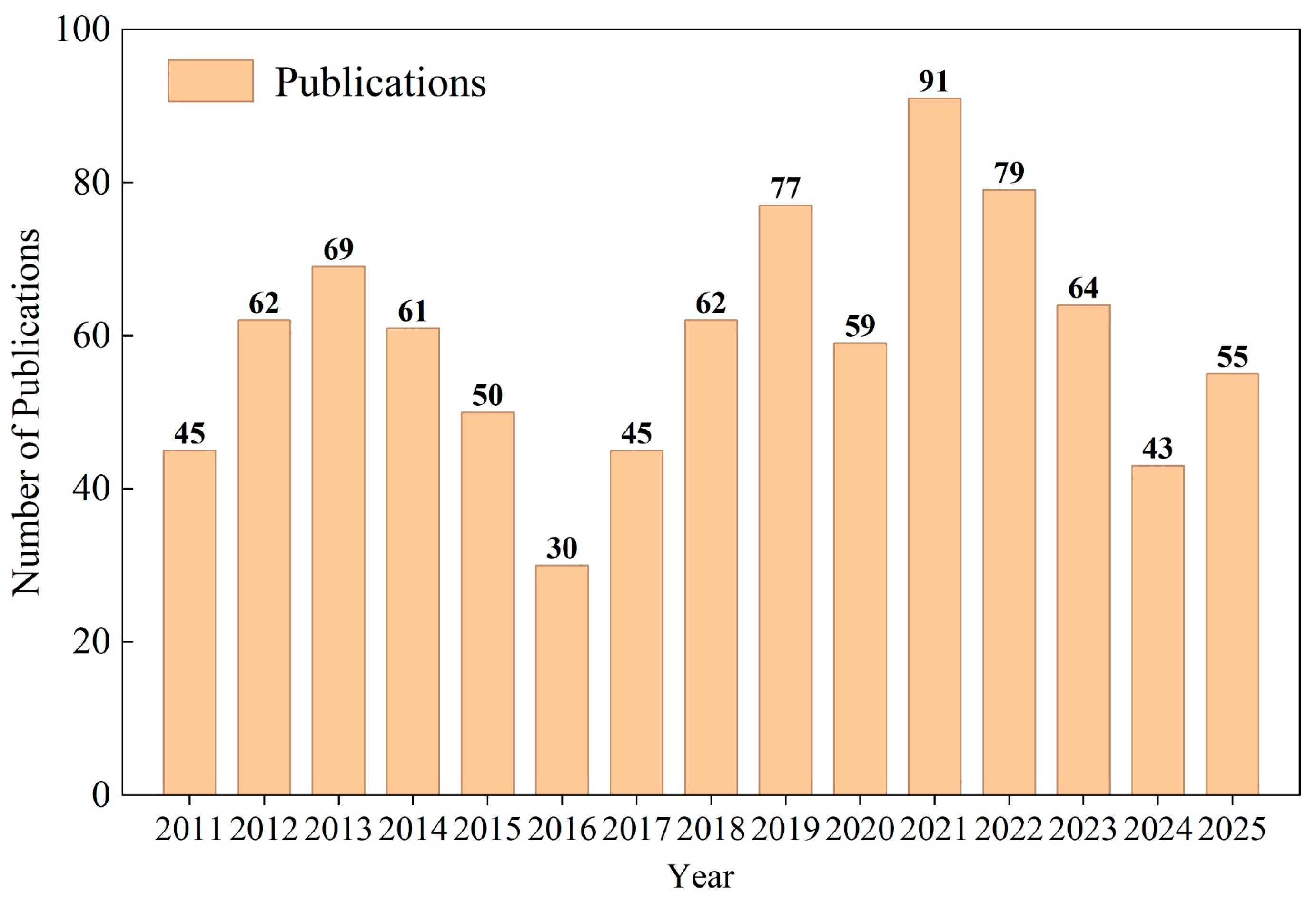

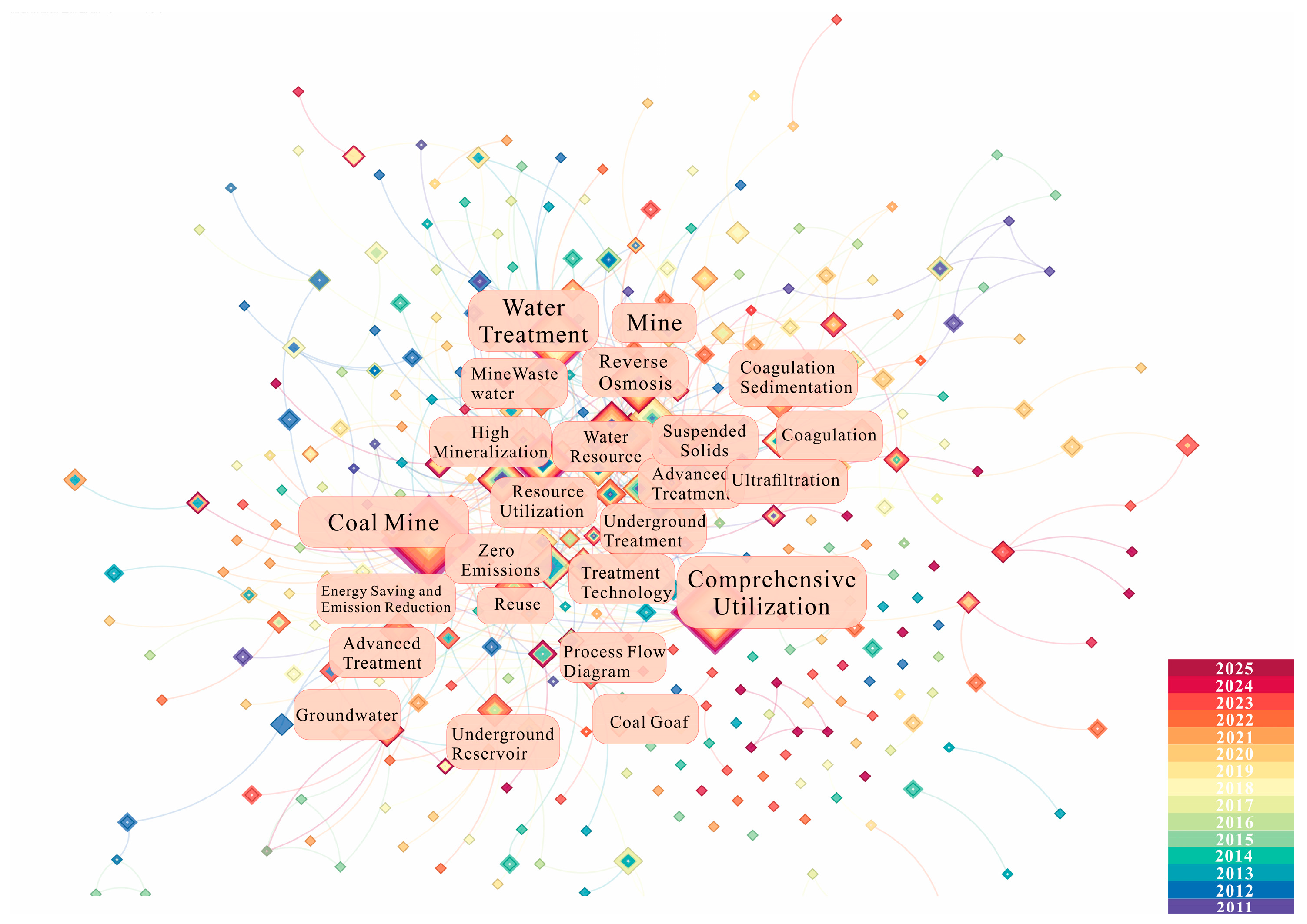
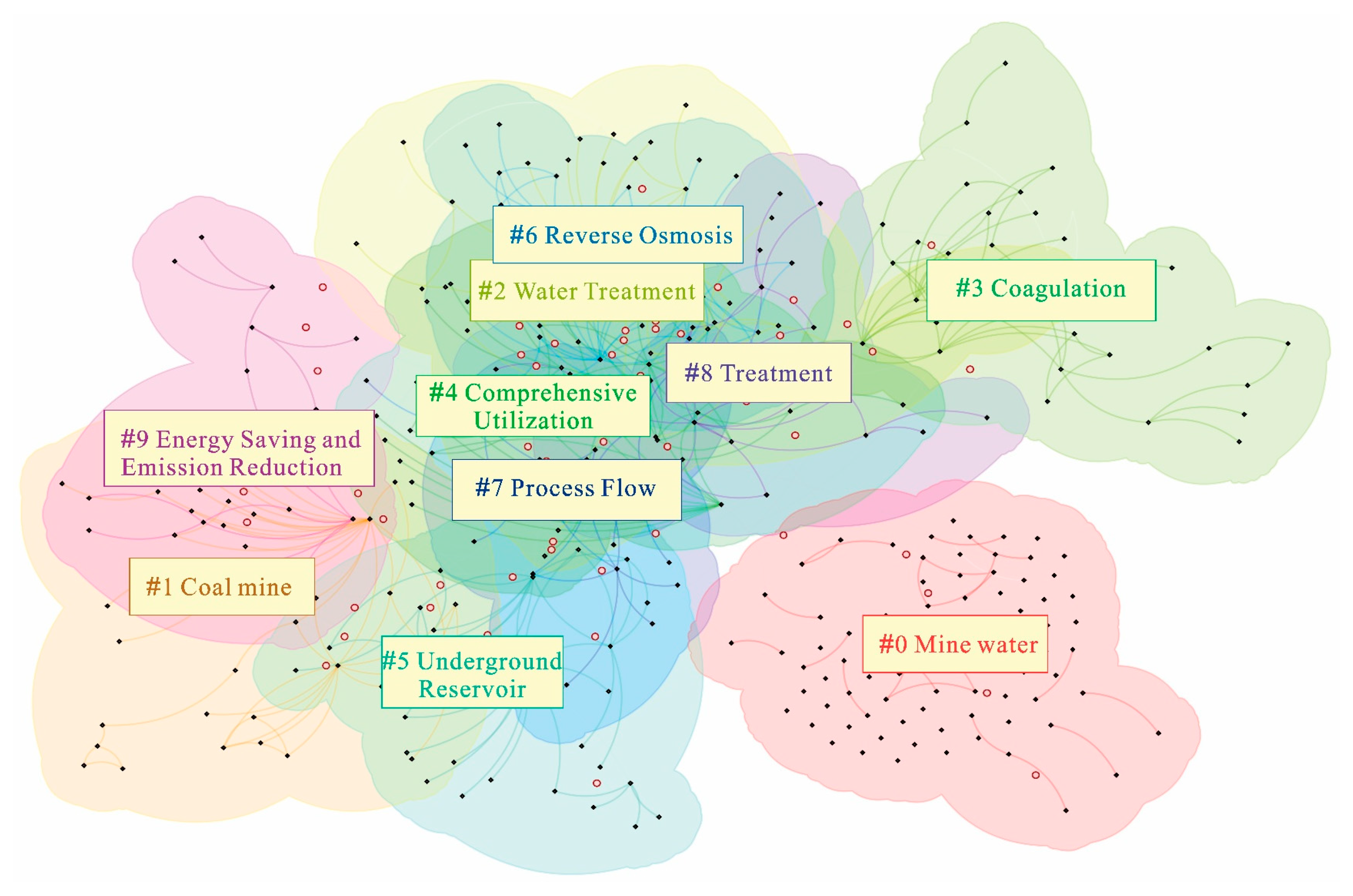
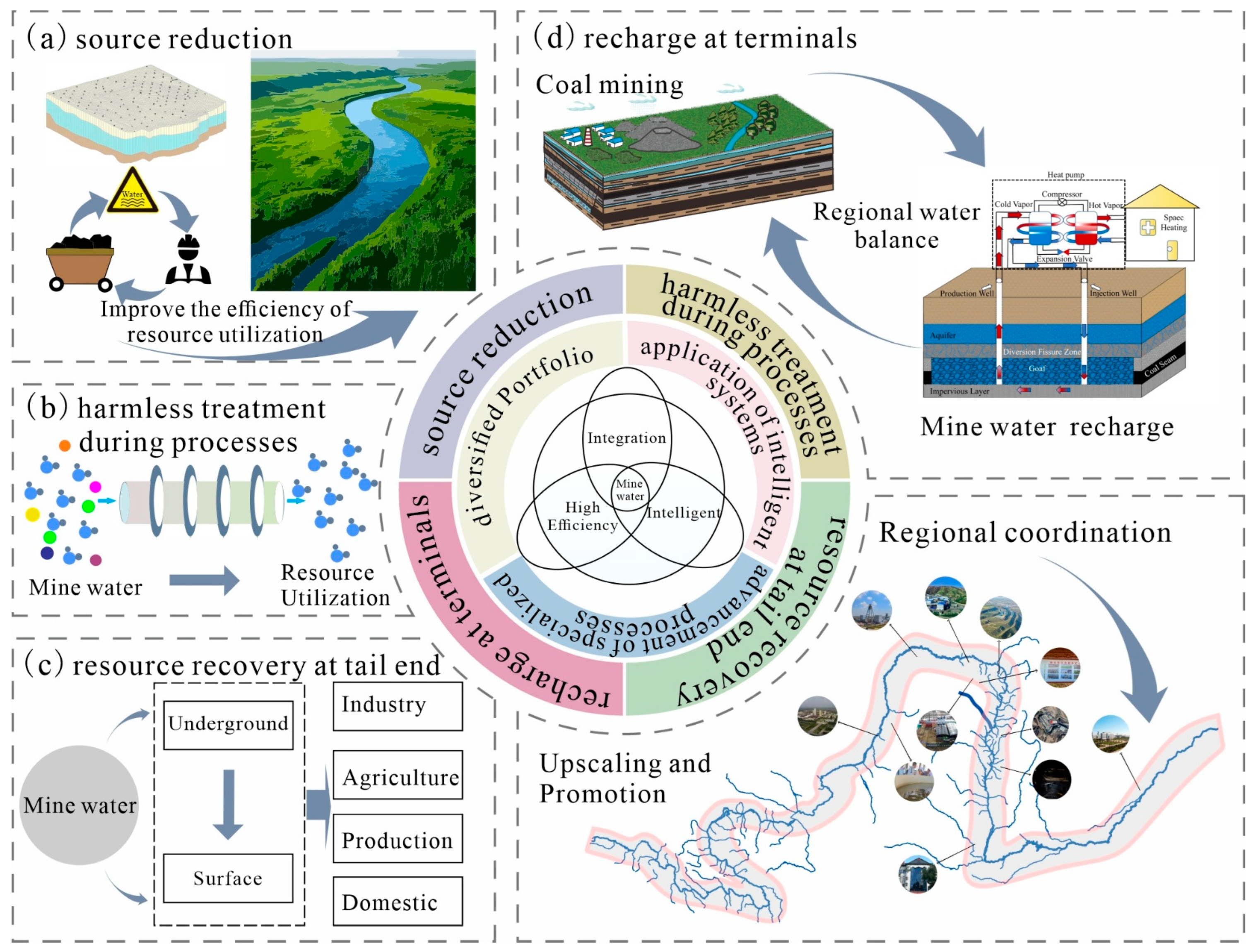
| Provinces (Autonomous Regions) | Average Water-Rich Coefficient |
|---|---|
| Henan | 3.75 |
| Sichuan | 3.02 |
| Shandong | 1.85 |
| Qinghai | 0.84 |
| Ningxia | 0.76 |
| Gansu | 0.74 |
| Shaanxi | 0.64 |
| Shanxi | 0.41 |
| Inner Mongolia | 0.24 |
| Period | Longitude of the Center of Gravity/(E) | Latitude of the Center of Gravity/(N) | Long Axis/km | Short Axis/km | Azimuth/(°) | 95% Confidence Interval (CI) of the Shift (ΔX/ΔY) | |
|---|---|---|---|---|---|---|---|
| Mine water production | H1 | 111°49′ | 35°55′ | 656.21 | 362.16 | 27.80 | |
| H2 | 111°58′ | 36°32′ | 575.37 | 342.80 | 24.28 | ΔX: [−0.127,0.476]° ΔY: [0.337,1.043]° * | |
| H3 | 111°52′ | 37°8′ | 514.96 | 323.47 | 20.58 | ΔX: [−0.398,0.133]° ΔY: [0.201,0.835]° * |
Disclaimer/Publisher’s Note: The statements, opinions and data contained in all publications are solely those of the individual author(s) and contributor(s) and not of MDPI and/or the editor(s). MDPI and/or the editor(s) disclaim responsibility for any injury to people or property resulting from any ideas, methods, instructions or products referred to in the content. |
© 2025 by the authors. Licensee MDPI, Basel, Switzerland. This article is an open access article distributed under the terms and conditions of the Creative Commons Attribution (CC BY) license (https://creativecommons.org/licenses/by/4.0/).
Share and Cite
Li, W.; Xie, H.; Sun, W.; Han, Y.; Jiang, X.; Huang, G.; Tao, P. Mine Water Production, Treatment, and Utilization in the Yellow River Basin: Spatial Patterns and Sustainable Transformation Pathways. Appl. Sci. 2025, 15, 12353. https://doi.org/10.3390/app152312353
Li W, Xie H, Sun W, Han Y, Jiang X, Huang G, Tao P. Mine Water Production, Treatment, and Utilization in the Yellow River Basin: Spatial Patterns and Sustainable Transformation Pathways. Applied Sciences. 2025; 15(23):12353. https://doi.org/10.3390/app152312353
Chicago/Turabian StyleLi, Wenjie, Hao Xie, Wenjie Sun, Yunchun Han, Xiaodong Jiang, Gang Huang, and Pengfei Tao. 2025. "Mine Water Production, Treatment, and Utilization in the Yellow River Basin: Spatial Patterns and Sustainable Transformation Pathways" Applied Sciences 15, no. 23: 12353. https://doi.org/10.3390/app152312353
APA StyleLi, W., Xie, H., Sun, W., Han, Y., Jiang, X., Huang, G., & Tao, P. (2025). Mine Water Production, Treatment, and Utilization in the Yellow River Basin: Spatial Patterns and Sustainable Transformation Pathways. Applied Sciences, 15(23), 12353. https://doi.org/10.3390/app152312353






